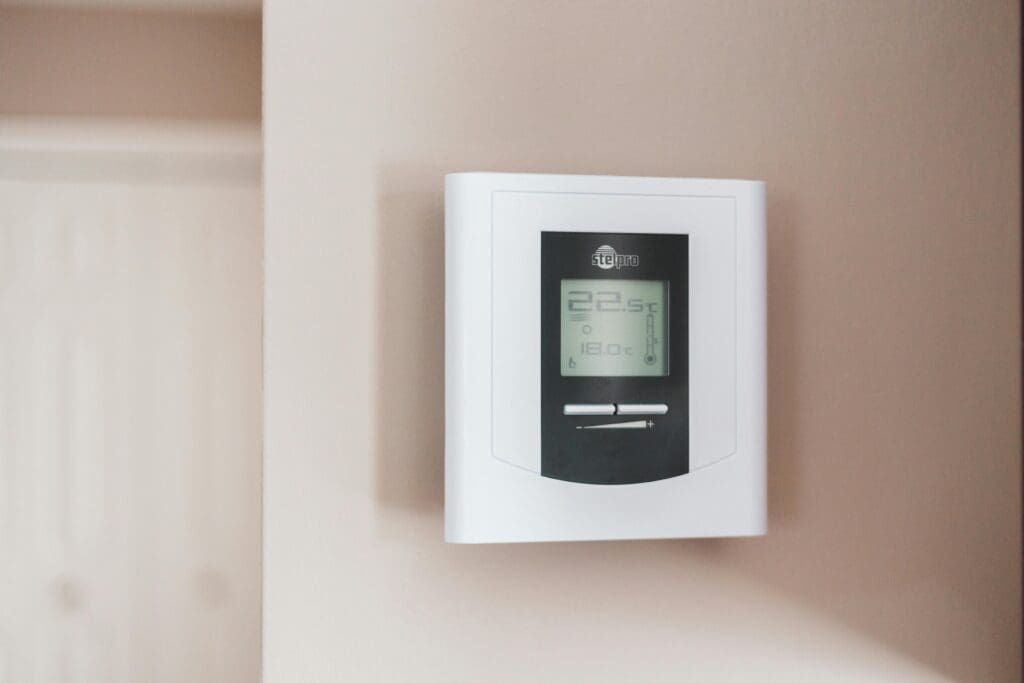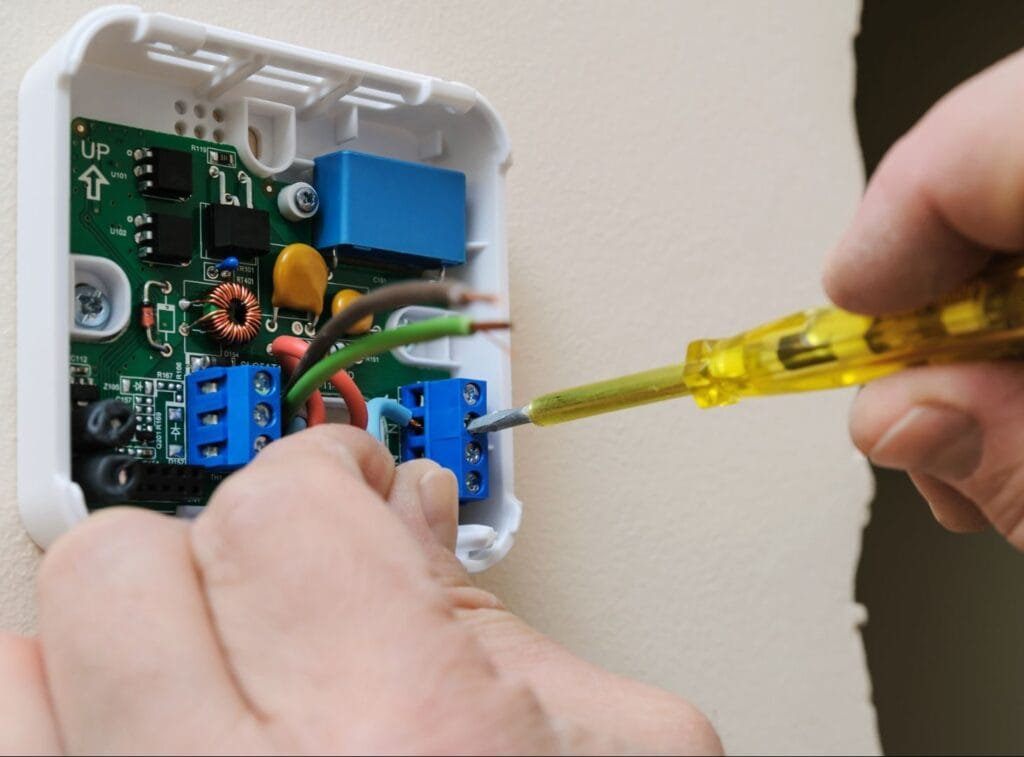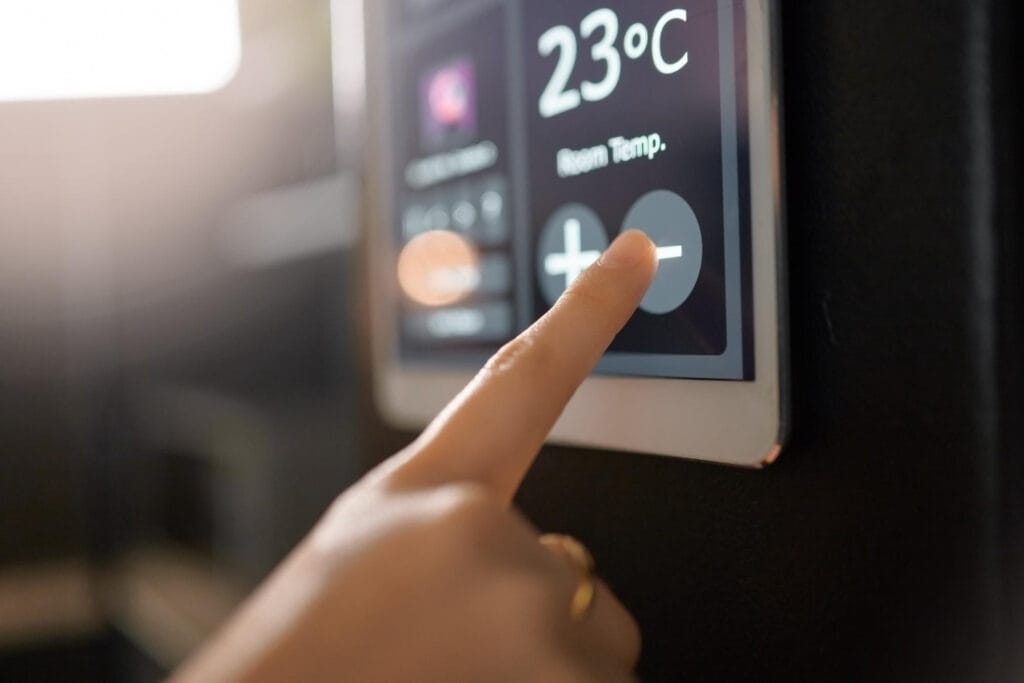A thermostat battery is a crucial component of your home’s HVAC system. It helps maintain a comfortable indoor environment.
But did you know that many thermostats rely on batteries to function properly? Yes, even those connected to your home’s electrical system.
These batteries serve as a backup, retaining your settings during power outages. They also power the display and controls.

However, like all batteries, they have a lifespan. When they start to fail, your thermostat—and by extension, your HVAC system—may not work as efficiently.
In this guide, we’ll delve into the world of thermostat batteries. We’ll explore the different types, their lifespans, and how to replace them.
Whether you’re a small business owner, a work-from-home professional, or a busy stay-at-home mom, this guide will equip you with the knowledge you need to keep your thermostat—and your HVAC system—in top shape.
Why Do Thermostats Have Batteries?
Thermostats are the brains of your HVAC system. They regulate the temperature settings that control your home’s heating and cooling. So, why do these devices need batteries, especially if they’re wired into your home’s electrical system?
Batteries in thermostats serve several important purposes:
- Backup Power: During a power outage, batteries keep the thermostat functioning and retain programmed settings.
- Powering Displays and Controls: Batteries ensure the display and control buttons work, even if the main power is off.
- Preventing System Interruptions: A battery-backed thermostat can continue operating without needing to reboot or lose settings.
Even in wired thermostats, batteries provide reliability and continuity. This prevents inconvenience in unexpected situations.
The presence of batteries also means fewer disruptions in your home’s climate control. And this ensures that your HVAC system operates efficiently and smoothly, even during power blips.
Understanding why thermostats have batteries highlights the importance of these small components. They play a significant role in maintaining comfort and efficiency in your home or business.
Types of Batteries Used in Thermostats
When it comes to powering your thermostat, several battery types may be used. The choice depends on the specific model and its requirements. Understanding these types can help you when it’s time for replacement.
Typically, the most common batteries found in thermostats include:
- AA and AAA Alkaline Batteries: These are widely used due to their affordability and availability.
- Lithium Coin Cell Batteries: Known for their compact size, these are often found in smaller, slim-profile thermostats.
- Rechargeable Batteries: Some smart thermostats use rechargeable options for convenience and sustainability.
Each type of battery comes with its own lifespan and performance expectations. For instance, alkaline batteries need more frequent replacement compared to lithium batteries. Lithium options often last longer, providing stable performance over time.
Choosing the right battery for your thermostat ensures optimal function. Always refer to your thermostat’s manual for recommended battery types. This keeps your system efficient and prevents any disruption in service. Using the correct batteries also contributes to maintaining the integrity of your HVAC system, ensuring that it runs smoothly and reliably year-round.
Signs Your Thermostat Battery Needs Replacement
Recognizing when your thermostat battery needs replacement is crucial to maintaining indoor comfort. One of the first signs is a low battery indicator on the thermostat display. This feature is designed to alert you before the battery is completely drained.
Another common symptom is an unresponsive thermostat. If pressing the controls doesn’t result in the expected changes, weak batteries might be the culprit. A blank screen is a more urgent signal that the batteries have likely failed altogether.

Inconsistent heating or cooling can also indicate battery issues. If your system isn’t maintaining the desired temperature, check the thermostat batteries first. Addressing these signs promptly can prevent disruptions and ensure your thermostat continues to operate efficiently, keeping your HVAC system in top shape.
How to Change Your Thermostat Battery: A Step-by-Step Guide
Changing your thermostat battery is a simple task that saves you time and maintains comfort. Here’s a quick guide to help you through the process. Remember, following these steps ensures a seamless transition to fresh batteries and continued thermostat efficiency.
Safety First: Turn off your HVAC system before you start. It’s a vital precaution to prevent accidents.
Locate and Access the Battery Compartment: Gently remove the thermostat from its wall mount. Check for a compartment door or cover.
Identify Battery Type and Replace: Note the current battery type and replacement orientation. Place new batteries accordingly.
Dispose of Old Batteries Properly: Proper disposal helps protect the environment. Use designated battery disposal facilities or recycling programs.
Test the Thermostat: Once replaced, reattach the thermostat and turn the power back on. Verify its function by adjusting the settings.
Reset if Necessary: Some models may require a reset. Consult the manual for specific instructions.
Step 1: Safety First
Before starting, ensure the HVAC system is off. This prevents any electrical hazards. It’s always better to be cautious when dealing with electrical components.
Step 2: Locate and Access the Battery Compartment
Carefully remove the thermostat from its wall fixture. Consult your thermostat manual if unsure. You may find a latch or button to access the compartment.
Step 3: Identify Battery Type and Replace
Observe the battery type and orientation before removal. Common types are AA, AAA, or coin cell. Place the new batteries in the same orientation as the old ones.
Step 4: Dispose of Old Batteries Properly
Old batteries should not be discarded with regular trash. Take them to a local recycling center. This ensures safe disposal and environmental protection.
Step 5: Test the Thermostat
Reattach the thermostat to its wall mount. Turn the system back on and adjust the temperature. Ensure the thermostat responds accurately to commands.
Step 6: Reset if Necessary
Some thermostats require a reset post-battery change. Refer to your model’s manual for guidance. This step ensures the thermostat operates correctly with new settings.
Extending the Life of Your Thermostat Batteries
Maximizing your thermostat battery lifespan is both cost-effective and convenient. Simple habits can prolong battery life and enhance your home comfort. These strategies are easy to implement and can save you frequent replacements.
Firstly, use high-quality batteries from trusted brands. Cheaper alternatives may have a shorter lifespan, leading to frequent changes. Investing in reliable batteries reduces the need for constant monitoring and replacement.

Secondly, avoid extreme temperature exposure. Batteries can deplete faster in high heat or frigid conditions. Keeping your home within a reasonable temperature range helps maintain optimal battery performance.
Additionally, consider the following tips to preserve battery life:
- Reduce Backlight Usage: Limit display backlight brightness and duration.
- Use Programmable Settings: Help your HVAC system run efficiently and reduce battery strain.
- Regular Maintenance Checks: Identify any underlying issues that could affect battery life.
Incorporating these practices can ensure your thermostat runs smoothly, leaving you with one less thing to worry about in your busy life.
Troubleshooting After Replacing Thermostat Batteries
You’ve replaced the batteries, but the thermostat still isn’t working right. Don’t panic; let’s explore some common troubleshooting tips. These can help you resolve issues without professional intervention.
First, ensure the batteries are installed correctly. Check the polarity to confirm that positive and negative ends align with the markings inside the compartment. Misaligned batteries are a frequent cause of malfunction.
If the thermostat remains unresponsive, try resetting it. Refer to your user manual for specific reset instructions related to your model. This step can often resolve minor glitches after a battery change.
Lastly, verify your thermostat’s connection to the HVAC system. Loose wires or connections can lead to operational issues. If these steps don’t solve the problem, it might be time to consult a professional. Your peace of mind is worth the call if technical solutions elude you.
When to Call a Professional for Thermostat Battery Issues
Sometimes, replacing the thermostat batteries doesn’t resolve the issue. In such cases, reaching out to a professional is wise. A trained HVAC technician can diagnose complex problems beyond a simple battery swap.
If you’re seeing repeated errors or your thermostat remains unresponsive, it could indicate a deeper issue. Perhaps wiring problems or system faults are at play. Calling a professional ensures a thorough check and repair. This approach saves you from further frustration and possible HVAC inefficiency. Remember, expert help is just a call away for reliable comfort in your home or business.
Conclusion: The Importance of Proper Thermostat Battery Maintenance
Ensuring that your thermostat batteries are in optimal condition is crucial for maintaining a comfortable indoor climate. Regular checks and timely replacements can prevent unexpected disruptions.
Proper maintenance not only ensures efficient HVAC operation but also prolongs the lifespan of your equipment. By keeping your thermostat functioning well, you help reduce energy costs and maintain a stable environment. Should you face any issues, don’t hesitate to contact LC Heating and Air Conditioning for expert assistance. With the right care, your system can provide reliable comfort year-round.


